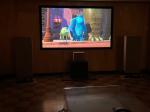The screen arrived quickly and was well packaged. Although the included assembly instructions are basic, if you watch on-line videos for similar products you will quickly get the gist of it. Once we began the process it all went easily. A key suggestion, however, is to use a better tool than the little allen wrench provided. We used a screwdriver with an appropriately sized hex head bit for the frame bolts and that made the frame assembly much easier. A power screwdriver will work also as long as you don't overdo it. After assembling the frame, we found that rolling out and stretching the screen fabric was much easier than we thought it might be. We started by attaching the screen to a few of the tensioning nuts at one corner, then went to the opposite corner, and worked our way like that around the frame. When done the screen was taut. The hardest part of assembly is adding the center stabilizer bar after the screen is stretched. Go in diagonally as the instructions indicate, but even then it's tough. We carefully used a small tap hammer to move the bar into position.To hang the screen you will need to measure, mark, drill into the wall and insert the mounting screws (and anchors, if needed) that are provided. Do this carefully so that the screen will be level when hung. You want the screw heads to stick out no more than about a half inch from the wall. Other reviewers have noted that it's difficult to align the mounting screws on the bottom. As long as your top screws are very securely fastened in the wall you may not need to use the bottom mounts; we did not. Please note, however, that ours is a 92" screen; larger screens may carry enough extra weight that you should also use the bottom mounts. In any case, if you can locate and screw the top mounting screws into wall studs rather than use drywall or other anchors, that would be ideal.Once your screws are in place you will most likely need two people to hang the screen: one on a step stool to reach behind the screen and place the mounting bracket attached to the top frame of the screen over the mounting screw in the wall, the other to hold the screen from below while that is being done. After you attach the first bracket, move to the other side and attach the other top mounting bracket in the same way. The brackets are designed to move horizontally so that the screen can be adjusted from left to right if needed after it is hung, but this is what makes it necessary for one person to "hand place" the brackets over the screws.If any of this sounds difficult, it really is not. The whole process took us less than a couple hours, and that's mostly because at our age we needed to take a few breaks. Anyone with some basic tools (screwdrivers, a tape measure, a drill and a level) with basic home maintenance skills should be capable of putting this together and hanging it without much difficulty.The screen looks great on the wall, and it provides a terrific image. We are using a 1080p projector that we
